Posted by Peg in South Carolina
As well as darling grandson
As a matter of fact, unbeknownst to me, she had been following my blog…….
As well as darling grandson
As a matter of fact, unbeknownst to me, she had been following my blog…….
And I am pleased.
For the curious, this time there was shrinkage across the width: 1”. This is the first time there was any shrinkage in this direction.
The shrinkage along the length was much less than after the first wash: only 1”.
To summarize: the towels went from 27” wide (width at reed) x 37” long (measured on loom and NOT including hems) to 24” wide by 31” long (NOT including hems).
Merry Christmas and Happy Holidays to everyone! This will probably be my last post till the new year.
The Latest Colour Sampler
Dot's Fiber to Fabric
As usual, Dorothy’s post has much of interest to me. I love investigating the interaction of colors as weft crosses warp. That is one reason I am so into crackle. But what Dorothy is dealing with is not one color crossing another color, but rather a duller color crossing a bright version of the color.
I have started playing with this theme in my recent crackle sampling and it will be very important to the crackle shawl/art piece I am in the process of designing. But I have never attempted anything resembling the systematic exploration that Dorothy is doing here. I am very impressed.
Also of great interest is her note to herself to sample new yarns. You can read the details of this by going to her blog post. I use pretty much the same yarns, but there are yarns that I am interested in trying and, when I do, I hope that I follow her advice.
Dorothy’s very systematic approach to matters of weaving is, I find, very inspiring.
Something New
A Crone's Chronicle
Oh dear, you-know-who get thee behind me.............(sob)! Connie Rose has come up with an absolutely wonderful idea for creative blog posts that I would really like to try. But I would have to start a second blog. Would that be a problem? I think it might keep me too much at the computer and away from weaving (and thinking about weaving). So, until such time as I can figure out a way to make this contribute to weaving, I think Connie's idea will be a no-go for me. But, oh............
What's on my Wheel? Pol-paca
Leigh’s Fiber Journal
I love to spin, and I love to weave with what I spin. Though I have spun enough to knit a sweater, and enough to weave a shawl, I don't think I could ever spin enough to weave enough fabric for a coat, which is what Leigh is doing. And for all of that fiber to be the same, as Leigh's is, no way.
I am so impressed by Leigh's peristence and patience. I think of myself as persistent, but despite the fact that she has noted in a comment, her Myers-Briggs results are identical to mine, Leigh's puts mine to shame. I guess for me, spinning will always be about relaxing and not even worrying that it may well never be made into anything.
In fact, what I have discovered that I like to do, is to take some batts (multi-colored and textured, usually) and spin maybe half a pound. Then I look at it and think, OK, that was fun. This might make a nice scarf or shawl, but it's not really enough. So I look at my stash for something that will work well with it; or I look at the batts and rovings my favorite suppliers have to see if there is something there. And then I order what I need (Ok, the right word is “want”, not “need”….) and spin some more.
Sometimes as I go through this process, I look at the singles and think, gosh, I think I'd rather not ply it on itself. I'd rather spin something else that would look nice plied with it.
For me this kind of spinning is sort of like painting a picture. The joy is in the process and the end product is good enough in my eyes just to be.
FIRST SURPRISE: NO SHRINKAGE ACROSS WIDTH
I have washed and pressed the towels. And measured them. There was no shrinkage across the width. But there was 5” shrinkage along the length. That is between 10% and 15%—quite within the normal expected range. I do not know if my pressing technique had an effect here. Instead of moving the iron lengthwise along the towels, a moved it width wise across the towels. There will be another washing before I am done and that time, if I remember, I will iron them lengthwise.
The major visible effect of this lengthwise shrinkage has been the conversion of the squares to rectangles! Now I understand clearly why one needs to wash samples……..
SECOND SURPRISE: SIZE OF OUTSIDE “SQUARES”
But, even though there was no shrinkage widthwise, there was a bit of rearrangement going on. Now the outside “squares” are only 1/4” narrower than the rest of the squares. Before washing, they had been 3/8” narrower.
Another surprise was that the reed marks still show. Not as much as they did before I washed them, but they still show. The black arrows point only to some of them. You may have to click on the photo to blow it up to really see them. Also, sitting back from the computer screen helps them become more visible.
FOURTH SURPRISE: TREADLING ERROR
Yet another surprise: a second treadling treadling error. Of course, this treadling error did not occur in the same towel the other one did. Actually this same error occurs twice, with only a few rows 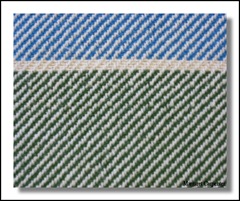
 in between.
in between.
This treadling error was a bit difficult to figure out. On one side it appears as green weft floats; on the other side as white warp floats. The only thing I can figure out is that my foot may have accidentally caught a neighboring treadle.
LAST SURPRISE: NO ZIGZAGGING
Still one more surprise, and on this very same towel. When I washed the towels I wondered where the mishmash of blue threads had come from when I removed the towels from the washing machine. Today I found out. When I went to press up the hems prior to sewing them, I saw that I had never zigzagged this edge! This failure did not result in total disaster, however. Only in a narrow him.
MY TOWEL
I had intended originally to keep one of the towels for myself. Now I know which one. This blue and green one with the treadling error and one narrow hem.
Tien has revived my interest in the possibility of weaving with knit blanks which I could dye and then unwind onto pirns for use as weft. In this process, the weft yarn is first knitted (on a knitting machine) and the resulting knit fabric is then dyed with the desired gradated color changes. After the knitted blank is dyed, it is unwound onto pirns or bobbins for weaving. Then one uses these bobbins in the correct order to weave with.
SOME NOTES ON HISTORY OF MACHINE-KNITTED BLANKS
Sara Lamb was the first person who I was aware, through her blog, of using this technique. She had learned of the process from her good friend Nancy Roberts. At that point Nancy had been machine knitting and dyeing blanks for hand knitters to use and so Sara pursued this. Go to her 2005 post “More Dyeing Fun” to learn how Sara dyed the blank and then hand-knit it.
Later that year, Nancy got the idea of machine knitting blanks not just for hand knitters but for weavers as well. So Sara agree to weave up one of Nancy’s machine knit and dyed samples. To see what she did with the blank, go to this post, A Little Help from my Friends. You won’t be disappointed with the eye candy that Sara provides.
The next year, Nancy presented a workshop for Sara’s guild. Sara talks about this workshop in her post, Dye Another Day. This was primarily about dyeing sock blanks for knitting socks.
While Sara often refers to this technique as “Nancy’s technique,” Nancy explained in an email conversation with me that her source was Rebekah Younger. To see some of Rebekah’s creations, go here. Rebekah had an article in a 1995 Threads Magazine on the technique, a technique she used for knitting.
An article on this technique can be found in the current Handwoven magazine (Issue 143, pp. 16-17). This is the story of the collaboration between Nancy and weaver Penny Peters. Here I learned that Nancy can make knit fabric even with 60/2 silk. Aha! My favorite weight of silk.
As a former machine knitter, and one who knit on a fine gauge machine at that, I had not believed it possible to use 60/2 silk in a knitting machine. And apparently Nancy wasn’t so sure either. But she found she could, and Penny’s weaving shows the brilliant results.
Now Tien is playing with the concept. Go here to read Tien’s description of her process along with wonderful photos.
MACHINE KNITTED BLANKS AND MY WEAVING
Reading Tien’s post on this process started me thinking once again about using it in my own work. I had not realized until Tien’s posts that anyone knit these blanks for sale. That meant, I realized, that even though I no longer had any knitting machines, I had easy access to purchasing knitted blanks. But I “knew” that of course 60/2 silk was out. Thanks to the piece in Handwoven I know that Nancy could knit me up 60/2 silk! Wonderful!
Right now, however, the kind of weaving I am doing does not seem to lend itself to using this technique. But were I to use it, I would not use it in the same way Tien does.
Tien is using very long colorways. In fact, looking at Tien’s photos, it looks like each of the colorways takes up enough yarn for one pirn, for a total of seven pirns. Elsewhere, however, she mentions that she is using 14 pirns. In any case, if I were to use such long color ways, it would for me make more sense to dye the yarns myself.
Dyeing the yarn in separate skeins would make it easier to make decisions as to when to stop weaving with one color and move to the next. As Tien makes clear, one has to calculate all this fairly accurately in advance.
Another advantage to doing the dyeing myself, I could choose on the fly when to move to the next bobbin. This would give me plenty of opportunity to play with (i.e., change my mind about……..) my original plans for working with the weft colors.
When I dye small bits of yarn I use canning jars and an electric frying pan to provide a water bath. The pan holds 8 jars. Actually I have two frying pans designated for dyeing and have been known to dye as many as 15 different yarns at a time. To dye 16 (or even more) gradations with two colors would require only that I make the two basic stock solutions and then gradually mix them into the number of dye pots I wanted. The number would be determined by just how smooth I wanted the gradations to be.
So, with long color changes, I’m not sure about the knitted blanks. If, however, the colors change relatively quickly, then I think the knitted blanks are a brilliant way to save some time as well a to reduce the number of weft ends that have to be woven into the fabric.
TO LEARN MORE
To find out more about this and to see examples of the beautiful things that have been created, go to Nancy Roberts’ website, Machine Knitting to Dye For. There is also a Machine Knitting to Dye For group on Ravelry.
I am indebted to Nancy for her help and advice with this post.
Related Post: Anger Despite Playing with Dyes
Many weavers seem to dislike the warping, threading, sleying, all the activities that go into getting the warp on the loom and ready to weave. I enjoy those activities. What I dislike is doing the finishing. When I cut a piece off the loom my mind tells me I am 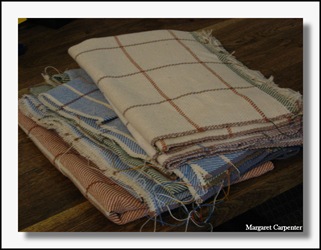 done and shuts down. I am ready to get on to the next piece. I have to use every trick in the book to get me to continue with the finishing.
done and shuts down. I am ready to get on to the next piece. I have to use every trick in the book to get me to continue with the finishing.
ZIGZAGGING EDGES
I have used the sewing machine to zigzag the edges of the towels to keep them from fraying. I have cut the towels apart. I now have what almost seems like a pile of towels. But they feel coarse. They look a bit like window screening. There is more work to be done before they morph into towels.
I need to get rid of all the weft yarns thrown in between each towel. I need to trim any threads not trimmed at the time of weaving. I need to check each towel for errors.
I did check for errors. The first error I spotted was a treadling error: I threw two consecutive shots in the same shed. It is at the hem border—the (more or less…) horizontal line of cream at the bottom shows two wefts each in the correct shed. But then, at the top of that line is an apparent thicker shot in a third shed. Actually that apparently thicker shot is really two shots in the same shed.
I may keep this towel for myself. I had planned on keeping one or two for myself, but then I had also changed my mind. Or I may simply point out the error to Amy as a reminder that her mother is not perfect. Not that she needs reminding, mind you.
And in the course of trimming up, I saw the occasional notch in the 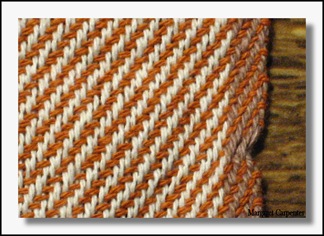 selvedge where one or more weft threads had caught and pulled tight when I threw the shuttle across the warp. The one in the photo was particularly bad. The rest are not nearly so obvious. Clearly my pirn winding, though much improved over what it was when I first started weaving with end feed shuttles, still needs work. But my eyes still need to be more attentive as I weave so I can catch these problems while it is still reasonable to unweave and correct.
selvedge where one or more weft threads had caught and pulled tight when I threw the shuttle across the warp. The one in the photo was particularly bad. The rest are not nearly so obvious. Clearly my pirn winding, though much improved over what it was when I first started weaving with end feed shuttles, still needs work. But my eyes still need to be more attentive as I weave so I can catch these problems while it is still reasonable to unweave and correct.
MEASUREMENTS
After I trimmed the towels up, I measured them. The first five towels were 25” wide. The last towel was 24 1/2” wide---narrower than the rest as expected. These were also the widths on the loom. That did not change. However, the width at the reed had been 27”, so that means there was either 2” or 2 1/2” of draw in, depending on which towel I am discussing. Roughly 10%, a figure that is in line with normal expectations. I expect more shrinkage widthwise after washing.
Measuring the length of each of them from edge to edge (which includes the hems), four of the towels measured 37” and two measured 38”. This, two I anticipated because I had gotten confused at some point whether I was measuring edge to edge or from the bottom of the towel to the other bottom of the towel, minus the hems. Next time I weave multiple items that I have to measure on the loom, I will attach a reminder to my little bulletin board on the castle. Right in front of my face………. Perhaps in red ink………..
WHAT REMAINS TO BE DONE
Now I need to wash, hang dry and press. Then sew the hems. For towels I use the sewing machine for this. Then I plan to wash them again and put them through the dryer this time, primarily to encourage more shrinkage, but also to soften them up a bit more.
I will not put them in the dryer the first time round because I have read that wrinkles will set in cotton if the fabric is not carefully pressed first. Once that initial press is over, the dryer will create no wrinkles. I do not know for sure whether or not this is true. I only know that that is how I finished dish towels I wove many years ago and there is never a wrinkle in them.
WHAT I’D RATHER BE DOING
I would so much rather be making the warp for my next piece…..
I would so much rather be working on the design for my next crackle piece…..
1. Simplicity can be very attractive. In some ways, with my penchant for working with very complex elements, this may have been the most interesting thing I learned. Perhaps the most important?
 2. My calculations were on target for warp length. I got six towels woven, with, as the photo to the left shows, only five to six more inches of possible weaving length.
2. My calculations were on target for warp length. I got six towels woven, with, as the photo to the left shows, only five to six more inches of possible weaving length.
On the other hand, I do not like to count on having to weave once the rod has passed over the back beam. Once the rod starts coming off the back beam things can happen, especially unexpected broken ends.
Visible in the photo are the selvedge weights I use. They are normally at the back. But the position of the back rod puts them in that rather strange position.
3. I found that my body built up its ability to withstand continuous weaving. That really surprised me. After the first week it was showing signs of objecting. But this second week I have felt as though I could weave all day with no problems. Of course, I didn’t trust that feeling!
PROBLEMS:
1. Size of Blocks. The wide blocks on the outside are each 3/8” narrower than the other blocks. As I had added additional treads to the brown stripes so they would end up the same size, so I should have added additional warp yarns to the outside blocks. I had not realized (though I should have known) that the draw-in would extend so far in. In fact, even the next block on either side is ever so slightly narrower than the remaining blocks.
2. Floating Selvedges. Nearing the end of the warp, I noticed that the floating selvedge on the right side had unplied and was sitting there as two singles. The only difference between the two sides that I could see was that quite a few heddles had slipped from the right side of the loom up snug against the threaded heddles. Usually I watch that pretty carefully. But this time, in the euphoria of weaving, I neglected to keep a watchful eye on those heddles. In any case, I continued weaving and that selevedge yarn never broke.
3. Selvedges. I had trouble with selvedges for about an inch or so near the end. I thought it was that my bobbin winding had deteriorated. Then it seemed that the weighted selvedge ends were not as taut as they usually are. I looked a bit and couldn’t figure it out. So I kept on weaving. At some point the selvedges started looking fine. I felt the selvedge warps and they were tight as a drum. Clearly the weights had somehow rested just a bit on the beam as the rods were moving to the top of the beam. I should have been more thorough in my checking.
3. Draw-in. There were no general draw-in problems except that the draw-in on the first towel was a little less than on the remaining towels. The next four towels stayed the same width throughout the weaving. This suggests I need to spend time just weaving for awhile on the warp so that the draw-in stabilizes.
![]() It was the last towel that the draw-in suddenly increased. In the photo you can see that the bottom layers are a bit wider than the rest. But then things settled down until I got to the last towel. There you can see the fabric gradually contracting.
It was the last towel that the draw-in suddenly increased. In the photo you can see that the bottom layers are a bit wider than the rest. But then things settled down until I got to the last towel. There you can see the fabric gradually contracting.
The only thing right now that I can think to attribute that to is the yarn I was using. I had not used this natural color for weft before. I noticed that it didn’t unwind smoothly. At times the weft yarn stuck so much that I found myself pinching the selvedges with my fingers so the weft wouldn’t yank the warp in. Perhaps somehow it was a bobbin-winding problem. Yet I went through three full bobbins and surely I hadn’t made a muck of all three?
I think the yarn itself must have been rougher than the dyed (or bleached) yarns. The solution then might have been to loosen up the tension on the bobbin. Still, the stickiness seemed to begin with the thread coming off the bobbin, not through the shuttle itself. So perhaps as I was nearing the end I grew careless in winding the pirns?
Related Posts:
Never Touch the Selvedges
Pirn Winding
Akihiko Izukura
Sampling for Acrylic Afghan
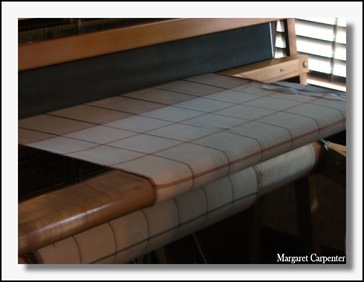 When I went to fill a pirn with white 8/2 cotton I discovered that that this white cotton that I have been weaving with is not the cotton I used for the warp. The 8/2 cotton I used as warp was a natural color. I remembered that I had ordered the natural and not the white.
When I went to fill a pirn with white 8/2 cotton I discovered that that this white cotton that I have been weaving with is not the cotton I used for the warp. The 8/2 cotton I used as warp was a natural color. I remembered that I had ordered the natural and not the white.
Apparently I had some cones of white 8/2 nearby, so when I went to wind weft, I wound white, not the natural. It worked out nicely. The white squares and lines are nice and clean, but the natural warp probably keeps the white from being blinding white---an effect I had not wanted and why I had ordered the natural.
But, for this last towel, I decided to weave with the natural instead of the white. And I decided to use the burnt orange I had used for the body of the first towel, for the horizontal stripes on this towel. The result is a slightly creamier looking towel. To appreciate the difference, the two towels would need to be seen right next to each other.
I think this last towel may be my favorite.
Related Post: Towel One Woven
"Final Towel" was written by Margaret Carpenter for Talking about Weaving and was originally posted on December 12, 2008. © 2008 Margaret Carpenter aka Peg in South Carolina
Dave’s idea of hanging yardage/scarves on a wall for display has been a great inspiration for me. He used hooks that he screwed into the wall onto which the hanging rod could be laid. Not willing to put needless holes into our walls, I went to the store and bought a pair of over-the-door hangers. Hanging my samples from them has worked like a charm.
But what is really good about them, is that they are a hung on a door that I constantly pass through. Now I find myself stopping and looking from time to time. Right now my focus goes to the part of the sample that is the impetus for the shawl I plan to weave.
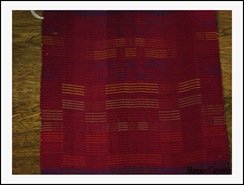 Today as I stood and stared at that part of the sample (photo to the left), ideas started coming into focus just a bit. I realized that I was looking at motifs—some primary, some secondary. Finally I couldn’t abide standing and looking any more. I grabbed the sampler off the hanger and took it to the computer. I brought up the notes I had started for the shawl and began typing away ideas.
Today as I stood and stared at that part of the sample (photo to the left), ideas started coming into focus just a bit. I realized that I was looking at motifs—some primary, some secondary. Finally I couldn’t abide standing and looking any more. I grabbed the sampler off the hanger and took it to the computer. I brought up the notes I had started for the shawl and began typing away ideas.
Ideas are starting to come. Many will be discarded almost immediately. Many will spur on more ideas. And so my excitement grows. Thank you, Dave.
Related Posts:
Resisting Doing the Work
Crackle Shawl/Art Piece
"Using Samples" was written by Margaret Carpenter for Talking about Weaving and was originally posted on December 11, 2008. © 2008 Margaret Carpenter aka Peg in South Carolina
I just realized that Leigh tagged me for this meme. Here are the instructions as they appeared in Leigh’s post:
*Go to your sixth picture folder and pick your sixth picture.
*Pray you remember the details.
*Tag five others.
My sixth picture folder is titled Christmas 2007. The sixth picture is of my 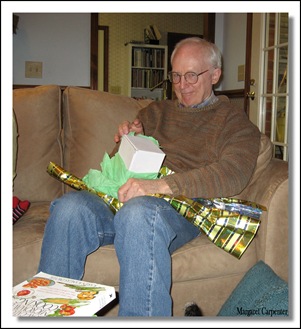 husband. I have no recollection whatsoever of the present he is opening…..
husband. I have no recollection whatsoever of the present he is opening…..
For those curious about such things, the room immediately behind Chuck (the room with the white bookcase) is the breakfast room where my loom resides.
Also, the sweater he is wearing was knit many years ago by yours truly when I was in my knitting machine phase.
These are the five bloggers I have tagged:
The Twisted Warp
Tien’s Blog
Centerweave
Thrums
WeaveGeek
Here, by the way, is one definition of meme that I found.
A meme (IPA: /mi:m/) is defined within memetic theory as a unit of cultural information, cultural evolution or diffusion that propagates from one mind to another analogously to the way in which a gene propagates from one organism to another as a unit of genetic information and of biological evolution. Multiple memes may propagate as cooperative groups called memeplexes (meme complexes).
I found many other definitions that were quite similar. I have no idea how the “tagging” community came up with this word.
"Photo Meme" was written by Margaret Carpenter for Talking about Weaving and was originally posted on December 10, 2008. © 2008 Margaret Carpenter aka Peg in South Carolina
The following sentences in the previous post are not correct:
I did the first blue. I did the second green. I did the third blue. I did the fourth blue……….
It should read, I did the first green. I did the second blue. I did the third blue……
"Towel 5: Correction" was written by Margaret Carpenter for Talking about Weaving and was originally posted on December 9, 2008. © 2008 Margaret Carpenter aka Peg in South Carolina
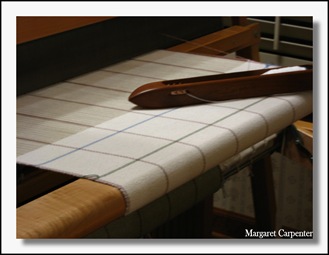 With this towel, my concentration began to flag. I had trouble keeping track of the count.
With this towel, my concentration began to flag. I had trouble keeping track of the count.
COUNTING
Basically I’ve been counting 1-and-1-and for the first of the four shots. 1 is the first treadle, and is the second, 1 is the third, and is the fourth. These are the four treadles I have tied up for the weave. Then I count 2-and-2-and and keep going till I finish with 5-and-5-and. Then I click my knitting counter. I do this 3 times. I will then have clicked my knitting counter 3 times. Then I weave 1-and through the second 2-and. And then 2 more treadles. But before I do these last 2 treadles, I measure, just to make sure. The second group 3 x 4 treadles is a little different, because I start with the second of the group. This means I end with the second of the group. And, before I do those last two, I measure.
This is really very simple and has served me well for the first four towels. But with this fifth towel I tended to make mistakes. More and more often I had to rely on measuring. Relying on measuring works, but I would like to figure out how to revive interest so that my attention does not flag. Perhaps a different way of counting?
IF YOU CAN’T DO IT PERFECTLY…….
This towel is quite different from the first four. The squares are white and the horizontal lines are blue and green. My intent was that the blue and green alternate. I did the first blue. I did the second green. I did the third blue. I did the fourth blue………. But I didn’t realize the error until I was almost finished weaving the next square.
Unwilling to unweave, I followed Laura’s dictum: if you can’t do it perfectly, do it consistently. So I have wove 1 green line and 2 blue lines. And who is to say that is imperfect? Who, except you the reader of this blog, who would know what the original intent was? Case closed.
BEATING
One of the things I noticed as I was weaving this towel is that the wefts do not lock in place as you weave. The last 3 wefts woven are a bit loose and nothing in the world will change that. But everything woven prior to those 3 wefts is just fine. I read once that when you beat, you are not beating in the weft just thrown but the weft 3 or 4 rows back. Now I understand what that means. Clicking on the picture to blow it up should reveal more clearly what I mean.
DENTING EFFECTS
The photo also shows (actually more clearly than the live fabric does) the effect of 2 ends in a dent. Little dark lines run down the photo, enclosing 2 ends with each pair of lines. These should come out in the wash.
"Towel 5" was written by Margaret Carpenter for Talking about Weaving and was originally posted on December 9, 2008. © 2008 Margaret Carpenter aka Peg in South Carolina
I now have only two dish towels left to weave. Actually only one-and-a-half towels! So I had better get hopping on to finalizing plans for the next project. This is going to be a shawl from some of my handspun.
CANVAS WEAVE
My first thoughts had been to do some kind of color-and-weave. Go here to read about that. But I changed my mind. When I re-read that post, by the way, I noted that I had changed my mind about the dish towels as well! Inspired by a scarf woven by Susan of Centerweave, I chose 4-shaft canvas weave as the weave structure for this scarf. Go here to see what Susan did with this structure. The draft, with the various treadlings I plan to try, is to the left. This structure is called canvas weave and is a kind of lace weave.
Go here to see what Susan did with this structure. The draft, with the various treadlings I plan to try, is to the left. This structure is called canvas weave and is a kind of lace weave.
SAMPLING
I have done a bit of lace weaving but no canvas weaving. Since this is a new weave for me, I decided that I should sample on some yarn that is not quite so “precious.” I need to work out problems of sett and colors, as well as treadling.
In my stash I found some Harrisville Shetland in light gray and light blue. These are leftover cones from a blanket I wove about four years ago. Two of the cones are to the right below. The size of this yarn (900 ypp) is very close to that of my handspun. And when I wove that blanket, it bloomed very nicely when I fulled it in the washing machine.
THE PLAN (AS OF NOW…..)
My plan is to put on a long enough warp both to sample the treadlings and to weave off a scarf. This assumes,  of course, that I have enough yarn!
of course, that I have enough yarn!
I am thinking of warping sort of wide stripes in the blue and the gray, not because I think that is what I might want to do, but because I want to see what happens with blue crossing gray and gray crossing blue. And, actually, I do want to see if using the two colors in stripes might work!
Related Post:
Handspun and Computing Sett: Part II
Spinning for Weaving
"Next Project: Handspun Shawl" was written by Margaret Carpenter for Talking about Weaving and was originally posted on December 8, 2008. © 2008 Margaret Carpenter aka Peg in South Carolina
I remember the Myer-Briggs test. For awhile it seemed that every committee I served on got to take it. It was argued that this would help us understand each other and so the committee could be more productive. I could never remember what type I was. I could never remember those letters that everyone I knew seemed to define themselves by. But even though the extreme focus on this test has passed, friends of mine still know their Myer-Briggs type!
Today I learned that there is a program that can define a blogger’s Myers-Briggs type. It’s called Typealyzer. All the blogger has to do is enter the url. So I entered mine. And here is what I got.
ESTP - The Doers
The active and play-ful type. They are especially attuned to people and things around them and often full of energy, talking, joking and engaging in physical out-door activities.
The Doers are happiest with action-filled work which craves their full attention and focus. They might be very impulsive and more keen on starting something new than following it through. They might have a problem with sitting still or remaining inactive for any period of time.
I have no idea how this program works. But it got at least some of me right. Energy, talking, engaging in physical out-door activities. Not so keen on follow through. Liking work which fully engages. And I cannot abide being a passenger in the car or watching a DVD without my hands being occupied.
If you want to take the actual test, go here. According to this website, ESTP personality types fall under the artisans class as opposed to idealists, guardians, and rationalists. So perhaps the blog reader got me right? I am NOT going to take the test itself to find out! Enough is enough.
And believe it or not there is a Google page which has links to all the various possible types. Go here if you are still keen on wasting time……
"Myer-Briggs and Blogs: A Bit of Friday Fun" was written by Margaret Carpenter for Talking about Weaving and was originally posted on December 5, 2008. © 2008 Margaret Carpenter aka Peg in South Carolina
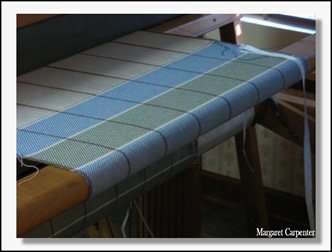 With this towel I am alternating bands of blue and green. Otherwise everything is still the same. Changing the colors this way helps to keep my interest up.
With this towel I am alternating bands of blue and green. Otherwise everything is still the same. Changing the colors this way helps to keep my interest up.
CONSISTENT BEATING
The slight beating inconsistencies I experienced with the first two towels have disappeared. Towel 3 and this beginning of towel 4 both have the same number of shots in each section.
DOUBLE BEATING
With towels 3 and 4 I have been double beating. That is, I beat before I change sheds, then I beat after I change sheds. But the second beat is not really a beat. I simply pull once again on the beater which has remained at the fell.
It appears that it has taken me roughly two yards or weaving to get the beat consistent!
"Towel 4 Begun" was written by Margaret Carpenter for Talking about Weaving and was originally posted on December 4, 2008. © 2008 Margaret Carpenter aka Peg in South Carolina
LIMITS AS A GOAD
I know I will never get another loom (well, maybe a table loom????), so I shall always be working with 8 shafts. That is really not a bad thing at all. In fact, it can be a very good thing because it is limits that result in creative effort. It is limits that force me to think.
There was a recent blog post that shows what beautiful results can happen when a weaver feels trapped by limits. It is the post Kaleidosilk Scarf posted by Dave at The Weaving Studio.
Back to the limitations of 8 shafts. I have begun to realize it is not so much the number of shafts that is limiting as it is the number of treadles. I have read on the weaving lists about adding treadles. That has seemed so beyond me. Until Dorothy wrote this post on her blog, Dot’s Fibre to Fabric: 14 Treadles on my Countermarche Loom. Well, maybe it still is beyond me. But........ Who knows........ Maybe?
BEAD LENO
Bead Leno is something I have always wanted to try. The idea of getting a really lacy open weave where the warp yarns wouldn't slip around really seemed incredible. The little I saw of it I simply did not understand. It seemed so mysterious. And now Linda has written a post which, while it does not describe the exact process, has clarified it enough for me that I think I might find it possible. When I have time............ The post is called Bead Leno and is found on her blog called Linda’s Weblog.
MAKING DO
I am always interested in those inventive people who can come up with solutions when they don't have all the right equipment. Tangled Threads has done this with her latest attempt at sectional warping without a spool rack. The title of her blog post is Beaming a Sectional Warp.......properly this time.
One of the most ingenious things I found was how she attached screw eyes to a scrap piece of board to give her yarns the guide they needed. These eyes are important in other aspects of weaving, in guiding thread from cone to warping board, for example. This is especially important if you are using a paddle. These eyes are also useful in guiding the thread from cone to bobbin winder.
I would add that a solution I have used for winding a warp with multiple threads (whether onto a warping board or in the sectional manner that Tangled Threads describes) is to take a reed and lay it flat between two chairs (or boxes, or whatever you have handy, as long as they are the same height). Put your cones behind the reed and guide the threads up through the slots in the reed and from there onto the back beam or onto the warping board. This was what I used to do until I bought Leclerc's cone holder, which will hold 8 cones of thread, with an eye for each of the cones. And those who are at all comfortable with tools could probably easily build one for themselves. Here is a link to a picture of one.
“EFFORTFUL STUDY”
I found this post by Tien to really speak to me. It said, so much better than I could ever have said, much of what I have learned through all the years of learning: Effortful Study Indeed, Tien’s post is largely responsible for my current reading, a book by Geoff Colvin: Talent Is Overrated: What Really Separates World-Class Performers from Everybody Else. I have read only the first two chapters so far, but am finding it a fascinating read.
PLAYING WITH COLOR
I use Paint Shop Pro to correct colors on a photograph. When I am engaged in this often frustrating task, I am so intensely focused on how to get the colors right, that I never think of playing with the software to see possibilities for color variations. Weaverly uses the more sophisticated Photoshop. But in her post called Theme and Variations she has opened my eyes to play! And I can do this with my software as well! (Do I really need to spend more time at the computer…………..)
POSTSCRIPT
If you have made it through this post, you probably have figured out that I have changed my way of approaching favorite posts. Doing this is much more helpful to me. I hope that others find it helpful as well.
"Some Interesting Blog Posts" was written by Margaret Carpenter for Talking about Weaving and was originally posted on December 3, 2008. © 2008 Margaret Carpenter aka Peg in South Carolina
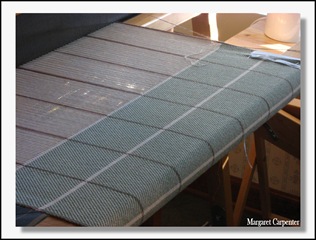 This one is green. My weaving is getting faster.
This one is green. My weaving is getting faster.
"Towel 3 Begun" was written by Margaret Carpenter for Talking about Weaving and was originally posted on December 2, 2008. © 2008 Margaret Carpenter aka Peg in South Carolina
I have spent the morning going through my carefully annotated sampling. Originally I had thought I was going to be working next with the last group of samples I had woven with gold as the background weft. I had thought I was going to work with the ideas there, but using a painted warp.
As I continued working with the samples my eyes kept returning to one of 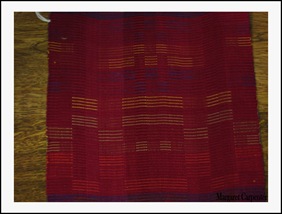 the earlier samples—the sample in the photo. I did some re-analyzing. In the process my imagination started working on what I would do with the threading to make a wider piece.
the earlier samples—the sample in the photo. I did some re-analyzing. In the process my imagination started working on what I would do with the threading to make a wider piece.
Then I figured out two things:
So now I am happily busy working the design out.
But I must not forget the towels for our daughter……
"Crackle Shawl/Art Piece" was written by Margaret Carpenter for Talking about Weaving and was originally posted on December 1, 2008. © 2008 Margaret Carpenter aka Peg in South Carolina

